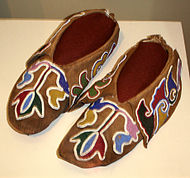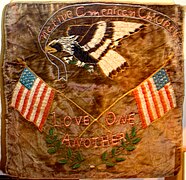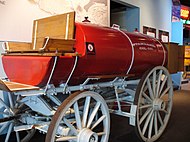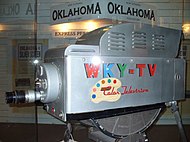Oklahoma History Center
hideThis article has multiple issues. Please help or discuss these issues on the talk page. (Learn how and when to remove these template messages)
|

The Oklahoma History Center (OHC) is the history museum of the state of Oklahoma. Located on an 18-acre (7.3 ha) plot across the street from the Governor's mansion at 800 Nazih Zuhdi Drive in Oklahoma City, the current museum opened in 2005 and is operated by the Oklahoma Historical Society (OHS). It focuses on the history of Oklahoma from ancient Native American tribal nations to the present day.[citation needed] The OHC was founded in 1893 by members of the Territorial Press Association[1] in Guthrie, Oklahoma, then the capital of Oklahoma Territory, but moved to Oklahoma City after statehood was declared in November 1907.{ https://www.oklahoman.com/article/862192/moving-the-capital}}
Inasmuch Gallery[]
The Inasmuch Foundation Gallery is located on the south end of the first floor.
The sections of the Inasmuch Foundation Gallery include culture and the arts; cultural diversity; images of Oklahoma; sports; voice; radio and television; vacuum tubes; and Wild West shows. Additionally, the gallery houses rotating exhibits on cultural diversity and the arts.
ONEOK Gallery[]
The ONEOK Gallery is located on the north end of the first floor. Representing all 39 American Indian tribes currently associated with Oklahoma, the exhibits describe the modern-day Indian experience as a bridge between the past and the present. The exhibits include artifacts, tribal music, photographic images, Indian art, and oral histories from the Indian tribes of Oklahoma.
The ONEOK Gallery topics include dwellings; Indian lives; languages; living ways; origins; sovereignty; spirituality; and tribes.
Kerr-McGee Gallery[]
The Kerr-McGee Gallery is located on the south end of the third floor. The gallery includes items from an 1830s riverboat recently excavated from the Red River, examples of Oklahoma's entrepreneurial history, and a 3-D reconstruction of an oil derrick.
The Kerr-McGee Gallery sections include the African American experience; business; military matters; natural resources; the oil and gas industry; people and pathways; and transportation.
Noble Foundation Gallery[]
The Noble Foundation Gallery is located on the north end of the third floor. Land runs and lotteries have played an enormous role in the development and settlement of the state.
The Noble Foundation Gallery sections include education; farming and ranching; fashions; government and politics; kitchens; the Dust Bowl; land runs; law and order; urban frontiers; and weather.
Special exhibits[]
Rock & Roll Exhibit - In 2009, the Oklahoma History Center hosted "Another Hot Oklahoma Night: A Rock & Roll Exhibit", a title that comes from the lyrics of a song by Oklahoma-born musician Michael Been.[2] This exhibit explored the rock and roll artists, radio stations, personalities, venues, and fans that have called Oklahoma home. Beyond the facts of each story, the exhibit showed how growing up in Oklahoma affected the music. These were displayed in an innovative style to encourage visitor participation and to ensure that the visitor would take away a new perspective on the history of rock and roll in Oklahoma. The exhibit was located in the E. L. & Thelma Gaylord Gallery on the extreme north end of the first floor. Additional exhibit components were located in the Inasmuch Foundation, Noble Foundation, and Kerr-McGee Galleries. This exhibit closed in 2011.
Tierra De Mi Familia - On November 22, 2008, the Oklahoma History Center opened a museum exhibit sharing the Latino experience in Oklahoma. The interactive exhibit used interviews, artifacts, documents, photographs, film, and music to explore both the impact of Latinos on the state of Oklahoma and the impact of the state of Oklahoma on the lives of Latinos. The exhibit integrated two story lines; the historical immigration of Latinos to Oklahoma, from territorial days to present, and the cultural folkways that Oklahoma's Latino people have brought with them from Central America, Mexico, the Caribbean, and South America.
This exhibit closed in 2012.
Oklahoma's Apollo 11 Moon Rock and Apollo 17 Goodwill Moon Rock- Rose Niang-Casey, a graduate student at the University of Phoenix, and a participant in the "Moon Rock Project", was assigned the task of hunting down the Oklahoma Apollo 11 moon rock and Apollo 17 Goodwill Moon Rock, two moon rocks the Nixon Administration gave to the people of Oklahoma. In both cases she discerned these moon rocks were properly on display at the Oklahoma History Center in Oklahoma City. She advised this is an exception to the rule, as most of these unique gifts that were given to the states and nations of the world have been poorly handled over the years.[3]
Special events[]
Oklahoma State Level History Day Competition - Each year, the Oklahoma History Center hosts the second of a three-stage (district, state, and national) competition called National History Day. Middle- and high school students can enter documentaries, historical papers, websites, exhibit boards, or performances on a topic that the students choose that relate to each year's theme. Students' projects are judged and advance to the national competition if they place first or second in their category.[4]
Gallery[]

Arapaho leggings and moccasins, ca. 1910

Otoe-Missouria beaded moccasins, ca. 1880

Shawnee Native American Church altar cloth

Standard Oil tank truck

Turner Turnpike display

Early color TV camera, WKY-TV

Fountain on OHS ground using native stones
References[]
- ^ "Oklahoma History Center launches Farmstead Cafe". Morning Ag Clips. July 22, 2019. Retrieved March 13, 2021.
- ^ Triplett, Gene. "Oklahoma-born rocker Michael Been dies in Belgium", The Oklahoman, August 20, 2010. Accessed August 20, 2010.
- ^ "Moon Rock Hunt Ends in State: A Michigan Student's Assignment Leads Her to the Oklahoma History Center, Which Possesses Two". Tulsa World, Deon Hampton, December 21, 2009.
- ^ [1]
External links[]
| Wikimedia Commons has media related to Oklahoma History Center. |
- Official website
- Oklahoma Historical Society
- TravelOK.com: Oklahoma History Center - info, photos, and video — official travel and tourism website for the State of Oklahoma.
- History museums in Oklahoma
- Museums in Oklahoma City
- Native American museums in Oklahoma
- Native Americans in Oklahoma City
- History centers
- Museums established in 2005
- History of Oklahoma
- Oklahoma Historical Society







